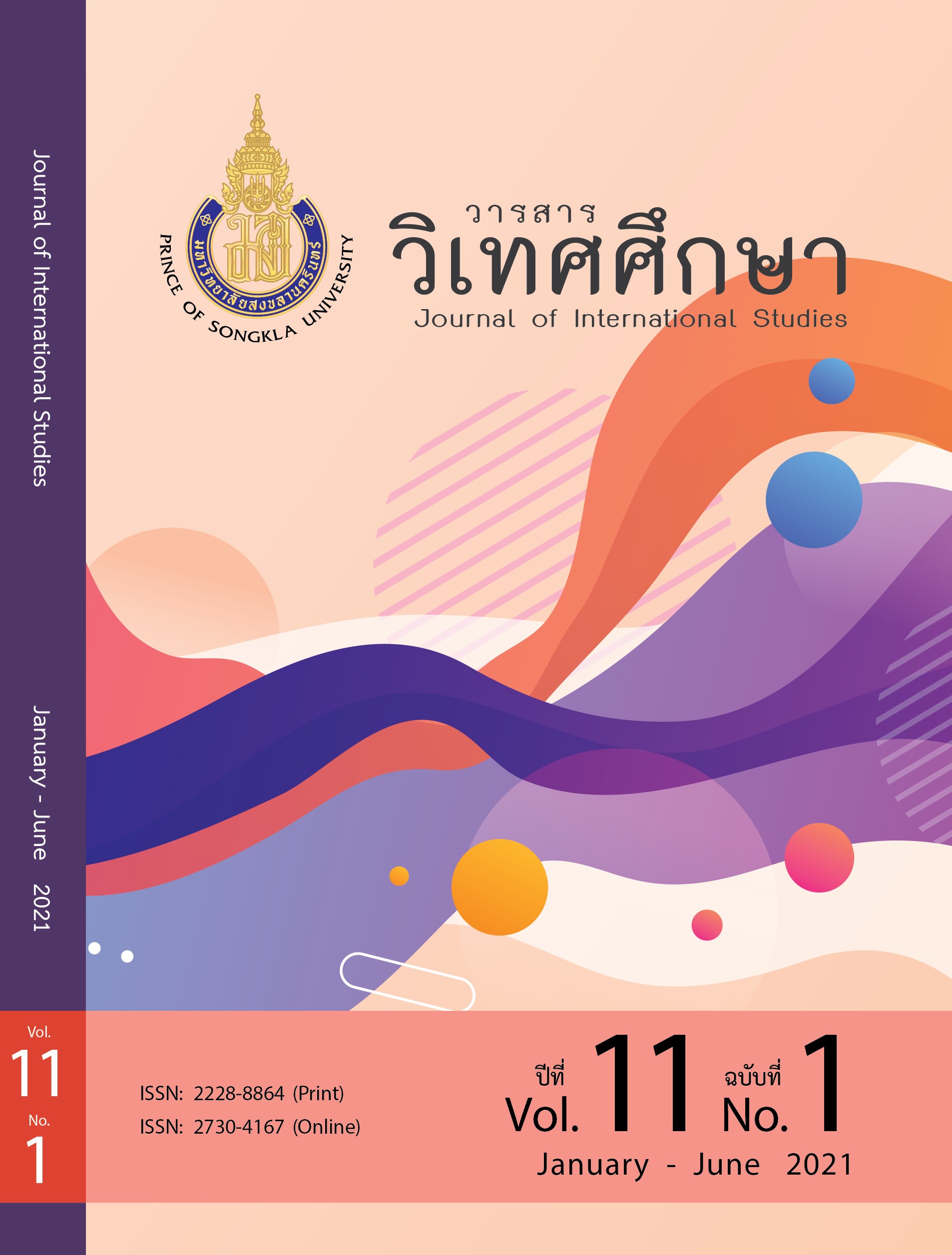Fostering Undergraduate Students’ English Grammatical Knowledge through Drama Activities
Main Article Content
Abstract
The present study was conducted to explore effects of drama activities on students’ English grammatical knowledge and to investigate their attitudes towards grammar learning experiences through drama activities. The participants included 125 second-year English major undergraduate students who were enrolled in the Practical English course in the first semester of the academic year 2017 at Prince of Songkla University, Surat Thani Campus. Data were collected using a grammar test administered before and after the implementation of the treatment. The mean scores the students obtained in the pre-test and the post-test were compared using paired sample t-test and Hedges’ g effect sizes. Students’ logs and attitudinal questionnaires were additionally used to collect qualitative data. The findings revealed a statistically significant difference between the mean scores the students obtained in the pre-test and post-test of grammar achievement test at a significant level of 0.05. Calculation of the effect size yielded a value of 1.14 which was considered large. The data obtained in students’ logs as well as attitudinal questionnaires reflected the students’ positive attitudes towards their grammar learning experiences through drama activities. It is suggested based on the findings that drama activities can be an effective alternative means to foster grammatical knowledge and to create positive attitudes towards learning grammar among learners of English as a foreign language.
Article Details
Statements and opinions expressed in articles herein are those of the authors and do not necessarily reflect the position of the editors or publisher.
Article, information, text, image, etc. which are published in Journal of International Studies, belong to Journal of International Studies. If anybody or any organization would like to use part or whole of them, they must receive written permission from Journal of International Studies before usage.
References
Adithepsathit, U. (2018). Beliefs about English language learning, attitudes and motivation of undergraduate students of Prince of Songkla University, Surat Thani Campus. Suranaree Journal of Social Science, 12(2), 24-46.
AI-Mekhlafi, A. M., & Nagaratnam, R. P. (2011). Difficulties in teaching and learning grammar in an EFL context. International Journal of Instruction, 4(2), 69-92. Retrieved on August 26, 2019, from https://files.eric.ed.gov/fulltext/ED522689. pdf .
Becker, L. A. (2000). Effect size (ES) Retrieved on June 26, 2011, from http://www2.jura.unihamburg.de/instkrim/kriminologie/Mitarbeiter/Enzmann/Lehre/StatIIKrim/EffectSizeBecker.pdf
Brown, H. D. (2000). Principles of language learning and teaching. New York: Longman.
Cam, L., & Tran, T. M. T. (2017). An evaluation of using games in teaching English grammar for first year English-majored students at Dong Nai Technology University. International Journal of Learning, Teaching and Educational Research, 16(7), 55-71.
Celce-Murcia, M., & Hills, S. (1988). Techniques and resources in teaching grammar. Oxford: Oxford University Press.
Cho, J. Y., & Lee, E. -H. (2014). Reducing confusion about grounded theory and quality content analysis: similarities and differences. The Qualitative Report, 19(64), 1-20. Retrieved from http://www.nova.edu/ssss/QR/QR19/cho64.pdf
Demirctoglu, S. (2010). Teaching English vocabulary to young learners via drama. Procedia Social and Behavioral Sciences, 2, 439-443. doi:10.1016/j.sbspro 2010.03.039
Fazio, R. H., & Petty, R. E. (2008). Attitudes: Their structure, function, and consequences. New York: Psychology Press Talor & Francis Group.
Hua, C., & Li, S. (2015). Bringing fun and meaning into grammar learning: a case study of a secondary-level EFL class in Hong Kong. Cogent Education, 2, 1-13. doi.org/10.1080/ 2331186x.2015.1111039
Inphoo, P., & Nomnian, S. (2019). Dramatizing a northeastern Thai folklore to lessen high school students’ communication anxiety. PASAA, 57, 33-66.
Janudom, R. (2009). The development of an English instructional model using the integration of drama and questioning techniques to enhance students’ speaking achievement and critical thinking skill. Doctor of Philosophy Dissertation, Chulalongkorn University.
Janudom, R. (2014). Enhancing Students’ Vocabulary Learning and Retention through Drama Activities. Pasaa Paritat Journal, 29, 117-146.
Krashen, S. D. (1981). Second language acquisition and second language learning. Oxford: Pergamon Press.
Krashen, S. D., & Terrel, T. D. (1983). The natural approach. Oxford: Pergamon Press.
Maley, A., & Duff, A. (2005). Drama techniques. Cambridge: Cambridge University Press.
Matas, C. P., & Natalo, M. (2011). Love grammar: Student-driven grammar learning games. The International Journal of Learning, 17(10), 371-382.
Nguyen, H. B., & Do, N. N. T. (2017). Students’ attitudes towards drama-based role play in oral performance. European Journal of Foreign Language Teaching, 2(3), 30-42. doi:10.5281/ zenodo.893585
Oskamp, S., & Schultz P. W. (2005). Attitudes and opinions. London: Lawrence Erlbaum Associates, Publishers.
Oxford, R. L. (1999). Anxiety and the language learner: New insights. In J. Arnold (Ed.) Affect in language learning (pp. 58-68). Cambridge, Cambridge University Press.
Purpura, J. E. (2004). Assessing grammar. Cambridge: Cambridge University Press.
Richards, J. C. (1996). Functional English grammar. Cambridge: Cambridge University Press.
Richards, J. C., & Reppen, R. (2014). Towards a pedagogy of grammar instruction. RELC Journal, 45(1), 5-25. doi: 10.1177/0033688214522622
Rinvolucri, M. (1984). Grammar games: cognitive, affective and drama activities for EFL students. Cambridge: Cambridge University Press.
Stern, S. L. (1980). Drama in second language learning from a psycholinguistic perspective. Language Learning, 30(1), 77-97.
Stevick, E. W. (1982). Teaching and learning languages. Cambridge: Cambridge University Press.
Thornbury, S. (1999). How to teach grammar. Harlow: Longman.
Thornbury, S. (2002). How to teach vocabulary. Harlow: Pearson Education Limited.
Tipmontree, S., & Tasanameelarp, A. (2018). The Effects of Role-Playing Simulation Activities on the Improvement of EFL Students’ Business English Oral Communication. The Journal of Asia TEFL, 15(3), 735-749.
Ur, P. (1988). Grammar practice activities: a practical guide for teachers. Cambridge: Cambridge University Press.
Ur, P. (2009). Grammar practice activities: A practical guide for teachers. Cambridge: Cambridge University Press.
Wadsworth, B. J. (1996). Piaget’s theory of cognitive and affective development. New York: Longman.
Widodo, H. P. (2006). Approaches and procedures for teaching grammar. English Teaching: Practice and Critique, 5(1), 122-141. Retrieved on May 15, 2014, from http://education.waikato.ac.nz/research/files/etpc/2006v5n1nar1.pdf
Wijitwanna, S. et al. (2013). Research for Teaching and Learning Development. Bangkok: Charoen-Dee-Mankong Press.
Yildiz, M., & Senel, M. (2017). Teaching Grammar through task-based language teaching to young EFL learners. The Reading Mtrix: An International Online Journal. Retrieved on August 30, 2018, from www.readingmatrix.com/files /17-a267g7f3.pdf


